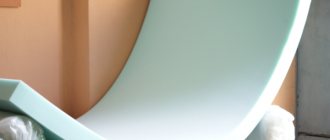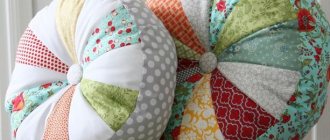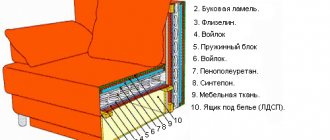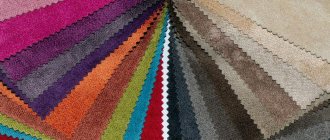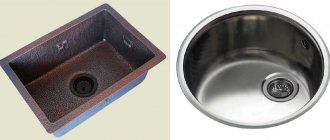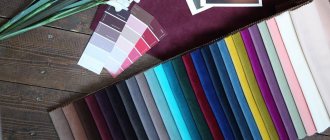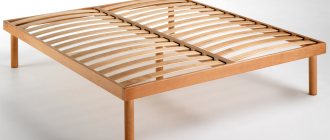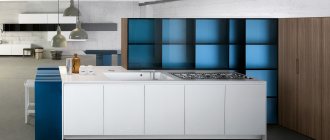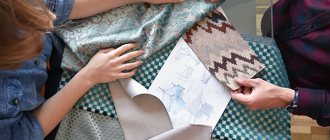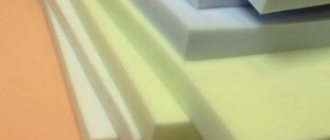Many manufacturers are trying to save money in the process of manufacturing upholstered furniture and use ordinary foam rubber as a filler. And if you understand that the appearance of the sofa continues to be attractive, but it becomes uncomfortable to sit on, this indicates that the foam rubber has become unusable and needs to be replaced with a new filler urgently.
If you don’t want to spend money and contact craftsmen, then you can easily do this work yourself at home. All you need is to stock up on the necessary tools and carefully follow the instructions that will be presented in today’s article.
Types by density
The higher its density, the longer the service life will be. By the letter indicators that appear on the label, you can navigate the types of foam rubber. Digital values indicate density indicators (the very first digit), subsequent ones indicate compression stress indicators.
Soft
Foam rubber is suitable for equipping sleeping places (sofas, beds, couches). Its approximate density is from 25 to 45 kg per 1 m3. Good indicators of softness, elasticity, and firmness provide comfort during sleep. There is no feeling of discomfort from sitting or staying in one position for a long time on such a sofa; you can relax in your sleeping place.
Soft material is designated with HS symbols. This marking is affixed to the packaging.
Attention
The product is quite pleasant to the touch, but not durable. You have to constantly repair or completely change the entire canvas.
Standard
Manufactured from a base polyol. It may include additional components to obtain the required strength, density and elasticity. Most often, this type of foam rubber is used for finishing armrests and headrests in upholstered furniture. Density - 25–30 kg per 1 m3.
Advice
To choose a standard foam rubber, you need to find the ST marking on the label, but also focus on the numerical values. They are indicated to show the buyer the density and compression stress.
The standard version is the most common on the market and can be used for restoration or self-assembly. The only and significant disadvantage is its low strength: foam rubber cannot withstand heavy loads. You cannot operate it with increased loads (it will not withstand more than 90 kg).
Hard
Not suitable for filling children's beds. This is a rather unpleasant option for relaxation. But it’s great for people who prefer hard surfaces to soft ones. Density - from 25 to 40 kg per 1m3. Marking: HL mark.
Ideal for sofas that are constantly used for sleeping. It is best to sleep on it rather than use it as a resting place for everyone.
Increased rigidity
Special polyols give increased rigidity to the product. They increase strength many times over, but this indicator depends on the components included in it. Density - 30 kg per 1 m3. An excellent material for making mattresses and sofa coverings. With a higher density value, the furniture can withstand increased loads. Marking - EL.
There is no weight limit. This is a comfortable option for a sound and long sleep. If you put another additional layer of foam rubber on top with increased comfort, the surface will become softer and more comfortable for sleeping in any position.
Highly elastic
It has a density of more than 30 kg per 1 m3 and can withstand a weight of 100 kg. Most often it is used to produce high-quality mattresses. The material has amazing load-bearing capacity and initial rigidity. High elasticity is marked on the packaging with the HR sign.
Advice
An exclusive option, quite expensive. These models are used for the production of luxury furniture, like the highest quality canvases listed.
Highly elastic with increased comfort
Comfortable furniture is made of foam rubber with a density of 30–55 kg per 1 m3. This is a soft material. You can relax, sleep, and sit comfortably on it. To select a highly elastic product with increased comfort, you need to find a label with the HR marking with an asterisk.
Highly elastic foam rubber with increased comfort is classified as one of the highest quality materials. It is chosen for luxury premises, where other options simply will not look good against the backdrop of luxury and wealth. Sleeping on such beds is simply unearthly bliss. The same goes for quality.
Attention
Foam rubber with such characteristics is not afraid of the most severe loads, it can be used around the clock and always lives up to expectations.
Mechanism repair
If during operation the back or seat does not fold or this happens with great effort, or they are skewed relative to each other, then repair of the mechanism for transforming the sofa-book is required.
The extent of the problem can only be discovered after disassembling the product. To do this, you first need to remove the armrests (most often they are secured with two bolts); in order to dismantle the moving parts, you need to unscrew the fasteners in the mechanism itself.
The system is now fully visible, but still attached to the sofa frame. If all components are intact, there is no play or other signs of loosening, you can simply lubricate it and lift the fastening bolt. Even the presence of rust does not mean complete failure. You can get rid of it using special chemicals.
How to replace it yourself: instructions
Tools and materials to change
To replace the foam rubber in the sofa you will need the following tools:
- set of wrenches;
- scissors for cutting material;
- side cutters, nippers;
- construction stapler;
- sewing machine;
- strong threads;
- accessories for decorating pillows (buttons, appliqués).
The best material is tapestry. It looks great and can be combined with other fabrics and textiles in the interior. Can be cleaned with any detergent without damaging the appearance.
For home upholstery the following are most often selected:
- flock;
- velours;
- jacquard.
Any type of fabric looks very elegant, even elegant, on the sofa.
Faux leather, if foam rubber is chosen, will not work. This is due to the fact that it is difficult to tighten it evenly on your own; it is better to entrust the work to the masters.
This article tells you what material is best to choose for upholstery and how to cover a sofa yourself.
Laying order: how to lay it?
Stages of work:
- All pillows, blankets, and decor are removed from the sofa. Then they begin to inspect the casing. It is necessary to turn the sofa so that it is convenient to inspect the frame. It is important to identify all wooden parts for fractures and rot.
- If the upholstery needs to be replaced, it is done immediately after the inspection. To do this, take fabric identical to the old coating. The frame is replaced by using special plywood and screws that will be suitable for working with the material.
- Carefully check the areas under the pillows. If the platform between them is broken, then make a support.
AdviceIn hardware stores you can purchase a special ready-made support (usually made of fiberboard or higher quality materials, depending on the manufacturer).
- You can additionally purchase thin plywood, which will completely match the size of the pillows, and lay it under them so that there is no squeezing under increased load.
- The integrity of the springs is an important test step. If they are bent or bent, they must be straightened and put in place with pliers. If the springs have become completely unusable, then they need to be replaced with new ones.
- Then check all the pillows one by one. The reason for the sinking of the sofa may also lie in them. If the sofa is too soft (whether such softness is initially upon purchase or after long-term use of the sofa), it is necessary to add a similar filler to the upper or lower parts and lay a foam seal.
- The frame and the back are strengthened with strong tape.
How to secure?
You can take out the old filler and use it to pattern a new one. Before fixing the layer, you need to carefully measure and cut out all the necessary elements according to the pattern.
The upholstery should fit tightly and beautifully. To do this, you need to firmly press it into the foam rubber at the places where the upholstery is attached to the base. In this case, this will help straighten the material and add elasticity.
The fabric should be stretched tightly with a construction stapler. The staples should be on the underside of existing parts. You cannot get into the joints and contact areas of individual parts - you can snag the upholstery and ruin its appearance. You need to pull the fabric tightly and secure it with a construction stapler.
Important
The staples should be located on the underside of the parts. There should be no overlap at the joints and adjacent parts to prevent damage to the upholstery and make it impossible to completely fold the sofa in the desired direction.
Assembly
Assembly is performed in reverse order. All elements are placed in place. You need to remember the disassembly steps in order to reassemble everything correctly. You can record the process on camera.
The cut filler should fit snugly against the wooden base of each piece. At this stage, you can add volume to the back and armrests due to a thicker layer of filler. The larger the size of the canvas, the more you will need to stretch and distribute the fabric along the edges.
The sides and back are assembled differently than the main middle part. A softer foam would be suitable here. These protruding elements are not subject to excessive stress and can easily be done without increased attention to them. If there is a spring block at the base, then a layer of tightly fixed fabric is placed on it (what if the spring block breaks?).
To do the job well, it is advisable to have canvas. You can take similar any other fabric. Every detail must be covered. Then the sofa or bed is assembled to the condition in which it was originally before disassembly.
Repair of sofa frame and armrests
Repair of the frame can only be done after removing the upholstery and filling, i.e. almost completely disassemble it. It is much easier if the seat and back are attached to the frame with a transformation mechanism. They can simply be removed by unscrewing a few bolts and screws, without touching the soft upholstery.
After accessing the damage, the defects must be carefully examined and decided whether the old part can be restored or whether it is better to replace it. To do this, self-tapping screws or bolts are unscrewed, the frame elements are measured, their exact copy is created and installed in place.
If you are doing other sofa repairs with your own hands, it is recommended to strengthen the supporting structures in each individual case (place a wooden beam, add a couple of cross boards, install metal corners). In addition, you can tighten the loose fasteners of the sofa, treat the joints with glue to prevent their play in the future.
Sometimes you need to restore armrests from which part of the wood has broken off. To do this, you should collect all the fragments (if there are several of them), determine the location of each and use PVA glue to glue them in place. Then all that remains is to lightly sand the gluing area and cover it with a layer of varnish matched to the color.
If you need to repair armrests with soft upholstery, first remove the fabric and foam rubber, and detach the broken part. The purchased one is installed in its place. The filling and fabric are returned to their place, and the armrest is screwed to the frame.
Types of spring blocks
All types of spring blocks can be divided according to the material and design of the springs themselves, and the filler used.
snake type is the simplest and most budget option. Used mainly in stationary (not folding) sofas. Withstands heavy loads, but with constant pressure in one sector it quickly stretches and loses its properties.
Bonnell (a single spring made of several parts) is used in the manufacture of inexpensive mattresses. A new sofa with a bonnel block is comfortable, but if at least one element breaks, it begins to creak, requiring repair.
A mattress with independent springs is the most reliable and comfortable, but expensive design solution. In the event of a breakdown, it is possible to replace a part, but this will require contacting a specialized workshop or manufacturer, since spare parts are sometimes difficult to find - as parts wear out, they lose their elasticity, and replacement parts are needed with exactly the same properties.
Mattresses for luxury furniture can be equipped with wooden springs . The price of a sofa is comparable to the cost of an inexpensive car.
Plastic parts are installed in combination with damping elastic materials in the manufacture of high-cost orthopedic mattresses. Such sofas cannot be repaired independently.
Video material
Proper use of foam rubber helps extend the life of furniture. The problem is that springs, which bear the greatest load from a person’s weight, wear out faster than “unloaded” ones. If you place foam rubber in the spaces between the springs and then cover the mattress with the same material, this will partially compensate for load changes, which means it will extend the life of the furniture. That's it, the renovation is over, it's time to put everything back and sit comfortably on the updated sofa!
Classification of springs
One of the criteria for the comfort and reliability of a design is the correct choice of a spring block. Let's take a closer look at the types of spring systems used by modern manufacturing enterprises.
Flat snake
- The simplest device.
- Long working life.
- Low cost.
- Comfort.
Important! There are also disadvantages. The springs bend (the so-called hammock effect). For this reason, products equipped with a folding mechanism are rarely made with flat springs.
Bonnels (solid spring units)
Benefits include:
- comfort (at the very beginning of use);
- low price.
However, over time, the spring blocks begin to creak.
Important! Since the design is dependent, if individual springs are damaged, the entire unit must be replaced.
Independent elements
Each element of the system is independent and separate from the others. Using an independent spring block provides the greatest comfort. If one element is damaged, only that element can be replaced. The system has only one drawback: high price.
Important! The service life of each of the described systems is different, and this affects the cost of the finished product. The most budget-friendly products have flat springs, and the most reliable and ergonomic models are equipped with independent spring blocks.
